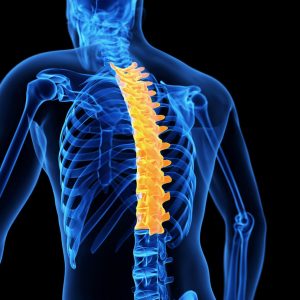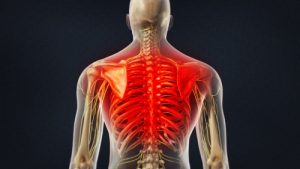This area of the body is the thoracic spine. It is generally poorly understood and managed. The way we assess and treat the thorax at PhysiYoga is the innovative, world-class Thoracic Ring ApproachTM and you won’t find it many other places in the world. So this topic warrants a deep dive. Let’s go!
Key: Understand that the thorax can be:
- Dysfunctional and non-painful
- Dysfunctional and painful
The thorax is such an important region of the body so whether or not it is painful, dysfunction in the thorax can drive problems in other areas by multiple mechanisms:

- It’s size: accounts for 20% the length of our body
- The weight it carries: The shoulder girdle rests over the thorax, so when the thorax moves side to side, it carries with it the weight of the shoulder girdle and the upper limbs.
- It’s location: it’s the middle of our body and has strong muscle attachments to the head, neck, shoulder girdle, abdominal wall, lumbar spine and pelvis
- It houses many important organs: the liver, lungs, heart and has a close relationship with the autonomic nervous system.
- The nerves to your abs exit your spinal column from the mid to lower part of your thorax – if you’ve tried in vain to strengthen your “core” for more than a month with no results then a dysfunctional thorax could be in your way!
The Thoracic Spine Should be Mobile
The thoracic region is our key centre for spinal rotation – when it becomes stiff and sore we lose our capacity to bend and twist well. Our thorax is also our body’s shock-absorbing spring, transferring loads from the pelvis through the arms, head and shoulders. It’s then clear that a stiff thorax doesn’t bode well for rotation type sports (think throwing, batting, tennis for example) or activities that need some shock absorption like running and jumping (if you feel a jarring in your back during these activities, this could be part of the problem).
The thorax is not inherently stiff and stable!
So the thorax is flexible with capacity for lots of movement. But if you can move it, you need to be able to control that movement. A sign of poor control in the thorax is a trunk and ribcage that behaves as through it is stiff and stable (this is because the body switches on too many muscles and creates a bracing effect for the thorax). Given this part of our spine makes up 20% of the length of our body, the rest of your body will be impacted by a stiff thorax.
A Stiff Thorax Impacts Your Whole Body
And it’s not just our opinion – consider this: poor trunk (thoracic spine and pelvis) control is correlated with a higher incidence of non-contact (i.e. jumping and landing funny) knee ACL injuries in female athletes (Zazulak 2007). But it makes sense – knees aren’t meant to move sideways. So if your trunk is doing too much of it, joints like the knee is going to be put under more strain.
Clinically we also recognise the relationship between the thorax and feet.
What causes the thorax to become dysfunctional?
The thorax can become dysfunctional from a variety of reasons.
- Repetitive activities, hobbies, jobs and sports (especially involving rotation and side bending)
- Lower limb injuries (like ankle sprains, knee injuries or hip pain) cause us to limp or lean to one side – we do this by shifting our thorax and sometimes this becomes a habit that persists after the injury has resolved
- Poor posture
- Sedentary work and life (lots of sitting)
- Knocks and falls
- Rib injuries (knocks, bruising or fractures)
- Shoulder injuries
What is Thoracic Pain?
- Pain in the region from the neck to the lower back (the rib-cage region of the spine)
- Pain may radiate along the line of the ribs to the front of the chest
- Pain may be felt as a “glove” type sensation around one or both hands

What Does Thoracic Dysfunction Feel Like?
- Stiffness to bend or twist the spine
- Maybe shoulder pain and stiffness
- Feeling effortful to sit or stand with good posture
- Neck stiffness
- “Jarring” feeling in your back when you run or jump
Common Injuries and Problems of the Thorax
- Increased thoracic kyphosis (forward bend)
- Scheuermann’s disease
- Scoliosis (a curve of the spine)
- Rib pain or injury
- Thoracic crush fractures
Try This
- Sit with your arms across your body and rotate your body left, then right. There should be equal and pain-free motion in both directions. If there isn’t, then your thorax isn’t functioning optimally
- To release your thorax, roll up a towel and lay down on it with your spine running along the length of the towel (use a pillow to support your head and neck if you need). Relax and breathe slowly (it should not be painful). Stay for 30 seconds to 2 minutes (whatever is comfortable for you).
- Retest your twist – did it improve?
How We Help
Emily is certified as a ConnectTherapyTM Practitioner which includes the Thoracic Ring ApproachTM. The Thoracic Ring Approach is a system to assess what impact the thorax is having on other regions of the body (and vice versa). It is the most sophisticated and comprehensive assessment and treatment approach for the thorax anywhere in the world. Bar none.
Emily mentors her team in this approach and we use it to assess and treat the thorax.
References
Lee LJ. (2008). Is It Time for a Closer Look At The Thorax? MPA In Touch magazine, an official publication of Musculoskeletal Physiotherapy Australia, a national group of the Australian Physiotherapy Association. Issue 1, 2008: 13-16. Accessed 9th October 2021 from https://ljlee.ca/research-publications-articles/
Lee, LJ. (2021). The Thoracic Ring Approach. Accessed 8th Oct 2021 from https://ljlee.ca/teaching-models/the-thoracic-ring-approach/
Lee LJ. (2013). Thoracic Ring Control: A Missing Link? MPA In Touch magazine, an of7icial publication of Musculoskeletal Physiotherapy Australia, a national group of the Australian Physiotherapy Association. Issue 4, 2013: 13F16. Accessed 9th October 2021 from https://ljlee.ca/research-publications-articles/
Zazulak BT, Hewett TE, Reeves NP, Goldberg B, Cholewicki J. Deficits in Neuromuscular Control of the Trunk Predict Knee Injury Risk: Prospective Biomechanical-Epidemiologic Study. The American Journal of Sports Medicine. 2007;35(7):1123-1130. doi:10.1177/0363546507301585. Accessed 8th Oct 2021 from https://journals.sagepub.com/doi/10.1177/0363546507301585

